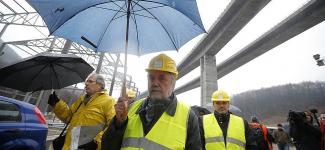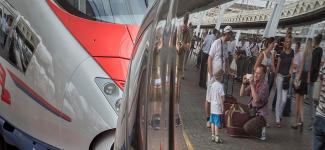Home › Projects › White Book › New transport design for METR region
New transport design for METR region

Paul Priestman, one of world's leading design experts, explains how to get rid of the stereotypes of the outdated infrastructure and why public transport can be as efficient as the Internet.
In 1985, whilst studying at London’s Royal College of Art, I visited China for the first time, funded by a series of design competitions I had won. I remember the way cities on the mainland looked then, thousands of people in Mao suits on bicycles. I now visit China a few times a year, where my company, PriestmanGoode, has an office. There are just as many thousands on China’s roads today, but the bicycles have been replaced with cars. This is a trend that we’ve been able to observe in many cities around the world, particularly in fast developing countries. Thankfully, this is starting to change. Rising environmental concerns over carbon emissions are making people – both decision makers and consumers – increasingly aware of the need to become more green.
While I’m a product designer by training, my company, PriestmanGoode, has, over the last fifteen years, specialised in transport design. In that time, the industry has changed enormously. Personally, my philosophy has always been to make things better and more efficient, not just for users, but to build, run and maintain. In recent years the need for sustainability has become tangible. Attitudes within the transport industry have changed, as has consumer behaviour. This, along with fast developing technology, means that today is a particularly exciting time to be working in transport. If you look at cities all around the world, infrastructure is struggling with the number of personal vehicles. I view my role as a transport designer to make public transport an attractive, comfortable option that will get people out of their cars and offer a sustainable long term solution for city-, country- and worldwide mobility.
As Global Creative Director of one of the world’s largest rolling stock manufacturers, CSR Sifang, I work on rail projects all over the world. And it’s interesting to observe that for an industry where technology is developing rapidly, the same level of innovation isn’t currently being applied to entire infrastructure networks. I think the advent of high speed rail, particularly in countries that are investing in largely new infrastructures, offers immense opportunities for innovation, for an overhaul of traditional rail networks, and an opportunity to herald the new age of rail, which is vital for the future of a sustainable economy.
Having worked on so many different projects has led me to think differently about things, to not accept the status quo and to constantly challenge the norm. I’m adamant, for instance, that there are better, more efficient, greener ways of running these new high technology trains, than by having them stop at stations. To that effect, my company developed the Moving Platforms concept, a completely inter-connected rail infrastructure where local trams connect to a network of non-stop high speed trains enabling passengers to travel from their local stop to a local address at their destination (even in another country) without getting off a train. The totally joined-up network would allow passengers to transfer directly from one moving tram or high speed train to another. This new infrastructure mimics the way the internet works, creating a system similar to the one that allows your home PC to connect to a computer on the other side of the world via a series of connected networks. It’s a big idea, but the technology is there. We can make shuttles dock in space, so docking trains is feasible.
All around the world, new 21st Century train services are being built on a station-based infrastructure that was designed in the 19th century for steam trains. We should be re-thinking infrastructure and building an inter-connected local-to-global rail network. Current plans for high speed rail will require a new network of major stations, taking up huge amounts of space and with a cost and environmental impact that is potentially vast. These stations function for the most part as large car parks that are packed during working hours and empty the rest of the time, and are only in use by passengers for short periods of the day.
In addition, a major problem with high speed trains is that they are not very fast. Slowing down and speeding up as they move between stations means they are only able to travel at their full speed for limited periods of time (wasting vast amounts of energy in the process). Many rail passengers use cars to get to their main-line embarkation station, so being able to link up to the high speed train directly from a local tram or train service means we could reduce car usage in towns and cities. Existing local stations would serve the feeder trams, enabling passengers from rural areas to access the high speed line easily. The infrastructure could also be used for local deliveries and freight, which would help get trucks off the road and ease congestion on motorways and in towns and cities.
While Moving Platforms is of course a big idea designed for future implementation, design thinking can equally be applied to small scale, low cost solutions to improve transport. Such was the case in Curitiba in Brazil, which developed a simple, clever solution to create one of the most efficient urban rapid transit systems in the world.
In the 1960s, city planners feared that population growth would lead to overcrowded development and a sharp increase in car ownership, which in turn would lead to congested roads and air pollution. As a result, they decided to change the face of the city and to invest in mass transit in order to make it the preferred mode of transport in the city. Today, 80% of the population of Curitiba gets to and from work through mass transit. The solution was simple. Dedicated lanes for the bus service, pre-boarding fare collection and raised waiting platforms that meant passengers – including those with reduced mobility – would be able to swiftly get on and off the bus.
This was a simple solution, which saw design thinking radically affect both the quality of the environment, and the experience for passengers. Crucially, local government officials in Curitiba had the foresight and the ambition to think differently and develop a long term solution. We need more design thinking at higher level, both in government and in transport companies, to ensure that the products and services being developed don’t just meet today’s needs, but foresee and solve tomorrow’s problems. Part of the issue of course is that many transport projects are led by governments that are only in power for terms between four and eight years, when infrastructure needs to be considered as long term investment. Thankfully, there does seem to be a general consensus around the world that investment in high speed rail and mass transit more generally is the way forward for a sustainable economy. But in order for this to work, we need to think about public transport, rail, metro, air rail and even walking as holistic systems. Cities need to be reclaimed by people and infrastructure made to improve quality of life for citizens.
One of the ways it can do this is by facilitating easier connections between different modes of transport, but also by using simple design thinking to encourage mass transit as the preferred option. A great example of this is the air-rail link in Hong Kong. While most airports around the world are designed such that as you step out of the arrivals terminal, you are faced with a bank of taxis, in Hong Kong, you step out and directly reach the air-rail link to the city centre. There, passengers need to make a concerted effort to try and find a taxi. This is a great example of how a simple change in architectural layout can radically affect human behaviour. More of this kind of thinking needs to be applied to our cities. We need to change them from car-centric societies to people and mass transit-led economies.
Aside from making it physically easier for passengers to choose mass transit, the other key area that needs to be developed is what the experience of public transport is like for passengers. My company is the leading aircraft interior design consultancy in the world, we’ve worked on countless projects for manufacturers like Airbus, Boeing and Embraer to airlines such as Turkish Airways, Thai Airways International, Air France, United Airlines and Qatar Airways to name just a few. And in aviation, passenger experience rules supreme.
I remember the first project we did for an airline. In the late nineties we designed the first lie flat seat for Virgin Atlantic. It might sound standard now, but at the time, it was a great step forward in improving the passenger experience. And looking back, we see the impact it had on the industry. It was a real catalyst for change. The first two airlines to offer lie flat seats were British Airways and Virgin Atlantic. Where competition between airlines had previously been just on price, it was now about comfort, and which airline offered the best passenger experience. Other airlines caught on and cabin interiors are now of the main tools that airlines use to differentiate themselves.
Arguably, there is less competition in rail, which in many countries consists mostly of government run services or single franchises running on particular lines. However, I would argue that the real competition lies with other modes of transport, particularly with car travel and short haul air travel. As the environment and reducing carbon emissions continues to be a priority for governments, creating an attractive and comfortable rail offering to get passengers out of their cars and out of the air must become paramount for rail operators.
Some countries already offer a superior passenger experience on trains. We’ve been working in China for a few years now where the main high speed trains include fully lie-flat rotating seats, so that passengers can always face the direction of travel. Carriages also include hot water dispensers so that passengers have access to tea. Whilst these may seem like small details, they are crucial to making passengers feel more comfortable.
In 2010, we designed a concept high speed train to offer a vision of what the future of high speed rail could look like. Our design included private berths in second class, which could be booked for business meetings or for families traveling together. The First Class carriage stood out from your run of the mill First Class carriages today and included a luxurious bar, viewing platform and sofas more reminiscent of a high end lounge. If we are going to offer a First Class product on rail, then it needs to be really First Class. If we’re going to lure passengers out of their cars – a comfortable, private environment - let’s offer them more than the alternative.
We also need to look at the ways in which the airline industry is embracing technology as part of the passenger experience. While the majority of rail passengers do have their own devices, whether tablets or mobile phones, there should be an opportunity for better integration of these within the fabric of trains, whether as source of entertainment or information.
And it’s not just long journeys that could benefit from a better passenger experience. As designers across all modes of public transport, we regularly work on airport train services, both inter-terminal or airport to city. The latter is one area that could hugely benefit from more design thinking. While it’s true that services like the Heathrow Express in London or the Arlanda Express in Stockholm (which is often lauded as one of the best air-rail services in the world) offer a comfortable journey, we need to look at what passengers need and how to make the best use of time on that journey. For business passengers, air-rail services are often the last chance to connect to their emails before a flight, or upon landing, the first opportunity to get in touch with their office. Our LoungeLink concept included individual working stations with adjustable privacy screens that would enable passengers to maximize their time in transit. The concept also included check in stations, all with a view to offering a stress free travel experience from home to destination.
While the airline industry is by no means perfect, airlines have for the most part understood the value of offering passengers a superior interior product to stay competitive. If we’re going to invest in new high speed rail systems around the world, it’s imperative that the experience of those trains is the very best that it can be so that passengers actually use them. Crucially, it’s important that they’re designed to solve tomorrow’s problems, not just today’s.
Longevity is at the heart of transport design. A train will have a lifecycle of up to 50 years, during which time technology, consumer behaviour and demographics are likely to see significant changes. Because of this, future proofing needs to be at the heart of transport design.
Some characteristics of the future train, for instance, are important for practical reasons. A double-decker train doubles capacity, which is crucial with growing passenger numbers and ever increasing population figures. A sleek, aerodynamic design is imperative for a train that travels at very high speeds. Trains must also be both hardwearing and flexible. Trains can change hands between operators, which often mean they will need to go through an internal re-brand. And advances in technology also mean that some elements of a vehicle may need to be replaced in order to be more efficient, as certain technologies become cheaper and more readily available. We know, for instance, that solar-panelled glass currently exists. And while at present it is too expensive to implement on a high speed train, the technology will undoubtedly become cheaper over the next few years as it is being perfected, which means that by the time a new vehicle is actually built, you may be able to use it. This is where design thinking is crucial to transport and infrastructure projects. Designers are trained to come up with solutions to tomorrow’s problems today. We know that around the world, populations are growing and age expectancy is rising. This means that in 20 years, trains will have to cope with higher passenger numbers, including a likely increase in passengers with reduced mobility for instance. Because with trains you’re designing objects that will be in service for 50 years, it’s imperative to create solutions for tomorrow’s demographics.
Finally, it’s important that rail and mass transit design be timeless. Vehicles should reflect a sense of place, visual heritage and stay away from the clichés of what the future might look like. We’ve just worked with Transport for London, creating the design vision for the new generation deep level Tube, which will launch in 2022. The design is inspired by contemporary London, its culture and architectural landmarks, and iconic British transport design. London’s Tube is one of the most iconic trains around the world. We are proud to have designed something that is part of the very fabric of London life, celebrating all that’s great about London’s environment: cutting edge technology, rich history and diversity.
Transport is one of the few areas of industrial design that has seen some truly iconic designs over time, including the Flying Scotsman, the Mallard, the Shinkansen, or more recently the new high speed trains in China. The latter are a great example of the way in which transport design – and mass-transit in particular – can act as a sign of modernity and economic prosperity, and fly the flag for a country’s achievements in technology and engineering around the world.
One of my main inspirations has always been Isambard Kingdom Brunel for his great ambition and vision. Big infrastructure projects rely on a long-term view and sometimes a touch of altruism to affect how we might live in the future. Political terms and short-term investment restrict what can be achieved in the future in order to make quick wins. We need to be thinking about the greater good to truly innovate and progress for subsequent generations. And design needs to be part of the process from the outset.
http://www.kommersant.ru/doc/2613720
Sign up for MIR initiative email updates
Sign up to receive monthly notifications about new arctiles published and other events on your email.






